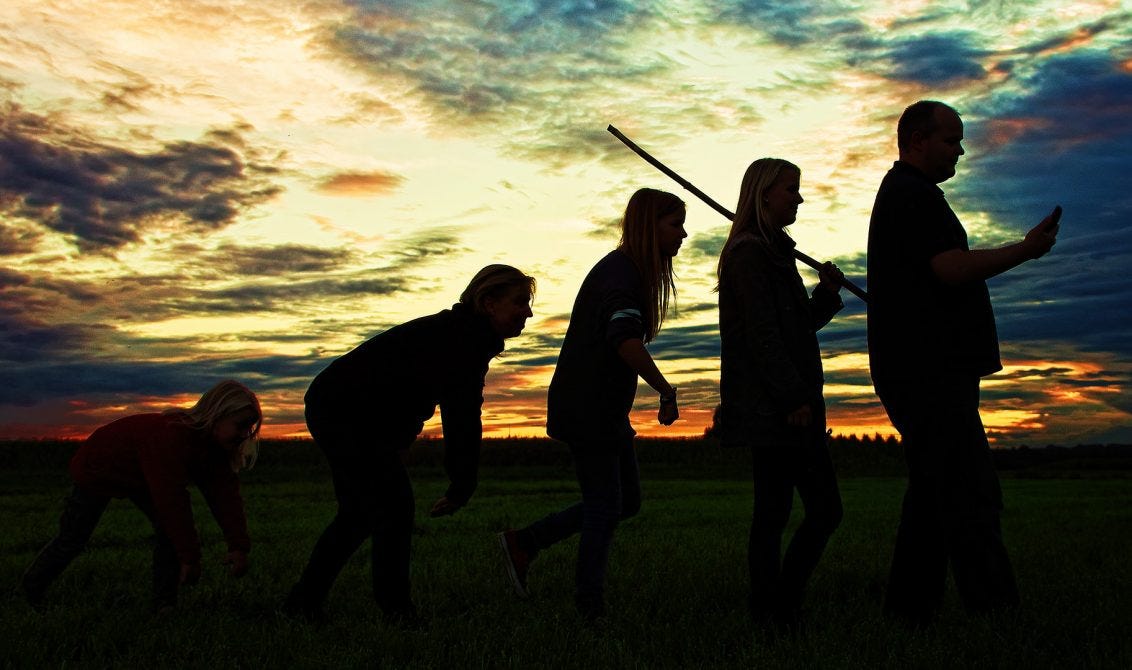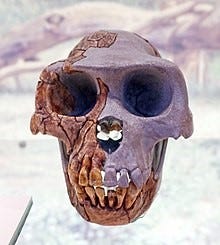Early Humans: Myth vs Reality
Part 3: Chimps, ‘chimp-men’ and early humans – a evolutionary genealogy or a genetic smorgasbord?
Written by: Professor Timothy Crowe
Part 3: Chimps, ‘chimp-men’ and early humans – a evolutionary genealogy or a genetic smorgasbord?
Picture it from your time machine - Africa millions of years ago (Mya)!
By 7 Mya, the Common Chimpanzee (Pan troglodytes) + Bonobo (P. paniscus) lineage was clearly divergent evolutionarily from that of the emerging Hominina (‘bridging’ ancestors of early ‘chimp-men’ and australopithecines - excluding Pan). Nevertheless, there was probably meaningful ‘hybridization’ (reticulate gene flow) between their ancestral and nascent – still reproductively compatible - Pan sister species from as far back as 10 Mya and as recently as 4 Mya. More of the same also probably continued between intervening hominin taxa along the australopithecine ‘route’ through to archaic humans.
In the end, there was ‘only one’ species - Homo sapiens. Or was there?
At the end of Part 2 of this series, the ‘big’ Great Apes - gorillas and orangutans - went out of contention in the ancestor/evolutionary-sister ‘competition’ vis-à-vis human evolution. Orangutans became evolutionarily genealogically (cladistically) as well as geographically ‘trapped’ - brachiating in the trees of primary tropical forests in Asia. Quadrupedal gorillas ‘knuckle-walked’ when they were on the ground and were disjunctly ‘jailed’ in island-like primary forest ‘refugia’ in Central Africa and evolved into giant diehard vegetarians.
In sharp contrast, bonobos - and especially chimps - ‘hedged’ their evolutionary biological ‘bets’. Chimp habitat plasticity allowed them to persist in and exploit African secondary forests and savannas. Moreover, both Pan spp., especially bonobos, could stand up and walk upright, had an omnivorous diet, reduced sexual dimorphism and assembled in large, multi-male-female groups capable of living and hunting cooperatively.
So, during 10-5 Mya, when rainfall in Africa trended lower, became more and more seasonal and savanna ecosystems expanded - displacing previously dominant tropical forest - the ancestral ‘Chimp-obo’ was pre-adapted to exploit the increasingly widespread savannas - just what was necessary to evolve into what became US. But, how did this happen?
To boldly go where no chimp had gone before
Sahelanthropus tschadensis Source: Wikimedia Commons
The oldest (7-6.2 Mya) putative fossil chimp-man is Sahelanthropus tschadensis. This fossil ‘hominin’ is represented by a single chimp-like skull somewhat crushed and distorted. It is anatomically intermediate between chimps and later-appearing australopithecine hominins. It had a chimp-sized (350 cc) brain, a moderately prognathous snout; reduced canines; heavily-browed supra-orbit; and suspected semi-erect posture - suggesting improved, but not habitual, bipedal locomotion.
Next (5.8-4.2 Mya) came Ardipithecus ramidus/kadabba.
Ardipithecus spp. Source: Spanish Museum of Natural Sciences
These chimp-sized hominins had: further reduced sexual size dimorphism; a chimp-sized brain - ca 20% of modern Homo; still further reduced and sexually monomorphic canines [upper canines shaped like diamonds, rather than pointed as in African apes - a derived feature shared with Australopithecus afarensis]; tooth roots similar to Sahelanthropus; tooth enamel thickness intermediate between that of Pan and Australopithecus spp.; reduced jaw prognathism; adaptations for both arboreal and facultative bipedal locomotion. They were not knuckle-walking quadrupeds.
Some key traits of its hand indicate how it may have been involved in locomotion. Its fingers were long relative to its estimated body size. Like arboreal apes, these bones also curved inwards, suggesting the hand was predisposed for grabbing tree limbs.
In short, Ardipithecus spp. - and probably other early hominins - retained some characteristics from an ancestor that was similar to chimpanzees and bonobos. They also share a third metacarpal styloid process with early hominins - absent in earlier apes. Adult ‘ardipiths’ had a facial anatomy similar to chimpanzee subadults – consistent with the hypothesis that hominins are neotenous Great Apes - retaining juvenile features in the adult. In comparison to the Great Apes, ardipith overall body proportions more closely resemble those of the Bonobo.
Australopithecines- - Australopithecus and Paranthropus spp.
Next come the australopithecine ‘Southern Apes’ Australopithecus spp. sensu lato - the remaining members of the subtribe Australopithecina: including Sahelanthropus and Ardipithecus. They evolved and diversified within eastern and southern African savanna-woodlands during 4.3-0.6 Mya.
These evolutionarily transitional hominins were chimp-sized with males being up to 35% larger than females. But, they had much larger-brains, ca 40% the size of H. sapiens. Like chimps, the were fully-furred and, in early forms, less erect and bipedal than the Homo spp. to come. Overall, they more closely resembled bonobos than chimps. The earliest appearing taxon, Australopithecus anamensis is morphologically most similar to Sahelanthropus and Ardipithecus spp.
Significant human-like changes to the australopithecine hand first appeared ca 3 Mya. These include an elongated. ‘opposable’ thumb relative to fingers and changes to the joints between the index finger and the trapezium and capitate. In terms of dentition, australopithecine molars were oriented in parallel and heavily enamelled, like those of chimpanzees. Their canines were smaller, but still larger and more pointed than those of modern humans. ‘Robust’ ‘Paranthropus’ species have intermediate orientation and much larger pre-molars and molars.
Australopiths also differed from chimpanzees and resembled humans in having a spine with 7 neck vertebrae, 12 thoracic vertebrae, and 5 flexible lumbar vertebrae.
By 3.6 Mya, australopiths were the first functionally – but not obligate - bipedal hominins. Biomechanical modeling also supports the hypothesis that australopith hand proportions had enhanced manual dexterity - consistent with improved manipulative performance. By ca 3 Mya they used primitive tools.
Evolutionary essence and relationships
Australopithecine taxonomy is, at best, in disarray (7-10 species, 1-4 genera) and their phylogenetic relationships – if any – are poorly understood. In reality, the various ‘species’ form an evolutionarily mosaic, transitional grade taxon - a paraphyletic segment of a cladogram (evolutionary genealogy) which does not include all the descendants of an ancestral taxon.
In the figure above, the green box (australopithecines) represents a paraphyletic evolutionary grade in between the blue (Homo spp.) and red (chimps and bonobos) monophyletic groups derived from a single common ancestor.
In short, given that Homo sapiens and Pan spp. are 96% similar genetically, australopithecines and, maybe some very early Homo spp., were probably reproductively ‘inter-connected’ ape-like morphs ‘characterized’ by a ‘smorgasbord’ of ancestral, transitional and relatively derived, human-like traits.
In terms of overall similarity, some palaeo-anthropologists divide australopithecine morphs into two ‘genera’: Australopithecus sensu stricto and Paranthropus.
Australopithecus sp. were ‘Gracile’ – more slightly built - prognathic and had a steep forehead. They had: smaller, more chimp-like brains; large/pointed incisors and canines and a more human-like, rounded skulls and less formidable molar and pre-molar teeth. Their diet was relatively diverse: insects, small animals, eggs, seeds, sedges, grasses, fruits and tubers.
Parantrhopus sp. were more ‘Robust’ and well-muscled and had ‘flatter’ faces and foreheads. Their skulls were larger, flat and heavily ‘boned’ (especially the jaws) with a prominent gorilla-like sagittal crest (SC) along the midline. They also had: larger brains (up to 550 cc), small incisors and canines, and formidable, heavily-enamelled premolar/molars. Their diet was primarily vegetarian: starchy, hard and abrasive low-quality grasses, fruits nuts and tubers.
There is also a distinct possibility that Australopithecus sensu lato may not even be ‘extinct’ - in the sense of having no living descendants. The genus Homo emerged from Australopithecus species 2.5-2 Mya, but early forms (e.g., H. habilis) possess a mixture of features of both genera – suggesting possible genetic mixing between the two lineages.
So, what ‘really’ happened
In short, during the transition from apes to humans, there were many – probably reproductively compatible - hominin evolutionary ‘candidates’ for humanity sprinkled across African savanna landscapes in space and time. However, few are unequivocally taxonomically justifiable species taxa. Species are historically discrete, irreversible, genetically and genealogically connected populations and lineages that are products of evolution – not morphs of a more inclusive, geographically and temporally single species. ‘Real’ species are characterized by multiple – ideally independent – homologous, qualitative, signifying similarities and differences derived from mutations, that become assembled within organisms and populations due to initially reversible effects of natural selection and genetic drift.
With few exceptions, currently recognized hominin fossil ‘species’ are typological entities based on fragments of bones from disarticulated skeletons. These ‘species’ were most often ‘diagnosed’ according to quantitively varying attributes and portrayed ‘phylogenetically’ in tree-like evolutionary genealogical depictions that, at best, reflected phenetic overall-similarity.
Abracadabra! From monkey-ing about to human-ing up.
In summary, the transition from the:
long-armed, small-brained, thick-skulled, long-snouted, big-fanged, massive-molared, noseless, furry, chinless, tree-sleeping, tool-less, fire-less, ‘stumbler’, sedentary, lightweight ‘shorty’ australopithecines to the short-armed, big-brained, thin-skulled, flat-faced, de-fanged, tiny-toothed, ‘nosy’, semi-naked, big-chinned, ground-dwelling, fired-up, mobile, travelling, ‘giant’ handy-man Homo was not a result of anagenetic evolution – gradually along an unbranching ‘Chain-of-Being’ – from a primitive ape to a derived ‘prime’ human.
It happened evolutionarily ‘instantly’ between 2.5 and 2 My. During that interval, there were as many as nine australopithecines and proto-homo evolving contemporaneously in the Dark Continent.
African hominin timeline (in Mya) – Source Wikipedia
To find out more about this explosive evolution have a look at Part 4. But, be ready for lots more interbreeding.
Timothy Crowe is an emeritus professor of evolutionary and conservation biology.









